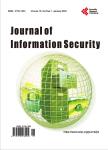Frequency Hopping Spread Spectrum Security Improvement with Encrypted Spreading Codes in a Partial Band Noise Jamming Environment
Frequency Hopping Spread Spectrum Security Improvement with Encrypted Spreading Codes in a Partial Band Noise Jamming Environment作者机构:Digital Cryptography and Coding Laboratory (DCCS Lab) Department of Electrical Engineering Iran University of Science and Technology Tehran Iran
出 版 物:《Journal of Information Security》 (信息安全(英文))
年 卷 期:2013年第4卷第1期
页 面:1-6页
学科分类:0810[工学-信息与通信工程] 08[工学] 081001[工学-通信与信息系统]
主 题:Frequency Hopping Spread Spectrum Key Distribution Centre Key Encryption Key Linear Feedback Shift Register Frequency Hopping Code Division Multiple Access Direct Sequence Spread Spectrum
摘 要:Frequency Hopping Spread Spectrum (FHSS) system is often deployed to protect wireless communication from jamming or to preclude undesired reception of the signal. Such themes can only be achieved if the jammer or undesired receiver does not have the knowledge of the spreading code. For this reason, unencrypted M-sequences are a deficient choice for the spreading code when a high level of security is required. The primary objective of this paper is to analyze vulnerability of linear feedback shift register (LFSRs) codes. Then, a new method based on encryption algorithm applied over spreading codes, named hidden frequency hopping is proposed to improve the security of FHSS. The proposed encryption security algorithm is highly reliable, and can be applied to all existing data communication systems based on spread spectrum techniques. Since the multi-user detection is an inherent characteristic for FHSS, the multi-user interference must be studied carefully. Hence, a new method called optimum pair “key-input selection is proposed which reduces interference below the desired constant threshold.



